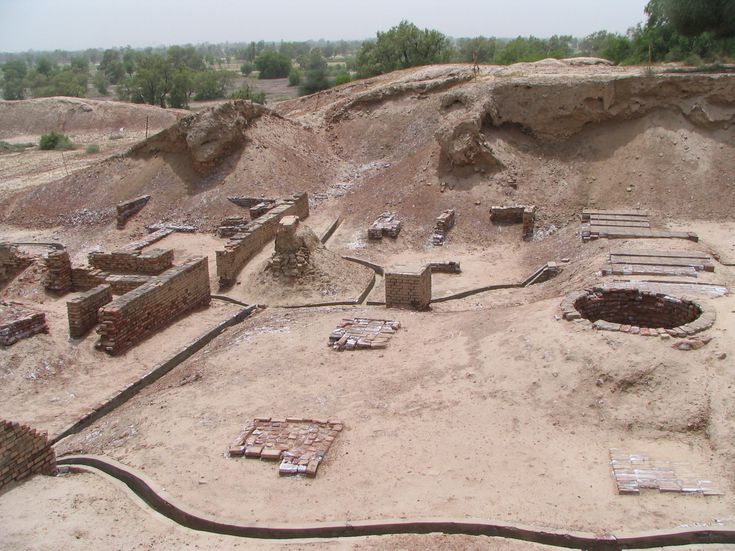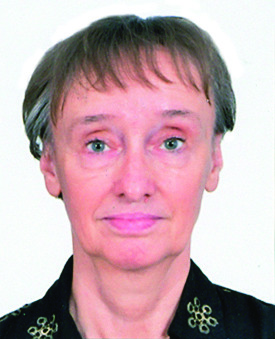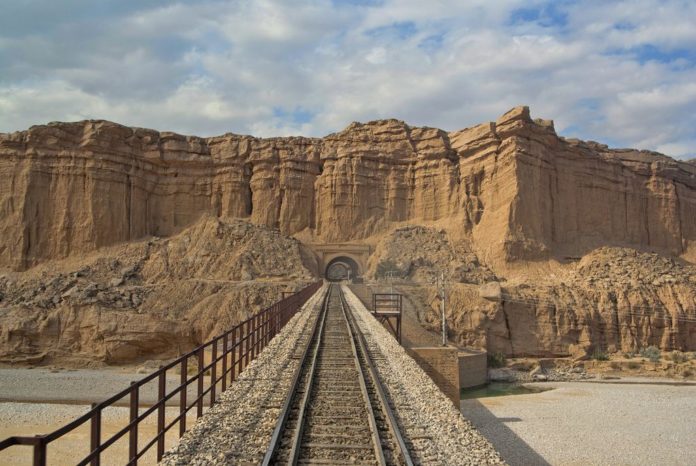Mehrgarh is a Stone Age site located at the foot of the Bolan Pass on the Kachi plain of Baluchistan in modern day Pakistan. Continuously occupied between about 7000 to 2600 BC, Mehrgarh is the earliest known Neolithic site in the northwest Indian subcontinent, with early evidence of farming (wheat and barley), herding (cattle, sheep, and goats) and metallurgy. The site is located on the principal route between what is now Afghanistan and the Indus Valley: this route was also undoubtedly part of a trading connection established quite early between the Near East and the Indian subcontinent. Having conducted initial excavations between 1975 and 1985 with help from the Department of Archaeology of Pakistan, renowned archaeologist Jean-Francois Jarrige returned to Mehrgarh in 1997 for more excavations lasting until 2000.
Archaeological material has been found in six mounds, and about 32,000 artifacts have been collected from the site. The earliest settlement at Mehrgarh located in the northeast corner of the 495-acre site was a small farming village dated between 7000 BC and 5500 BC. Based on these findings it has been established that Mehrgarh is one of the earliest known archaeological sites that shows evidence of farming and herding in South Asia. It precedes Mohenjo Daro and scientists think that when Mehrgarh civilization came to an end it migrated to the Indus valley and laid the fundamentals of the Indus valley civilization.
Archaeologists divide the occupation at the site into eight periods. The Mehrgarh Period I (pre-7000 BC – 5500 BC) was Neolithic and without the use of pottery. The earliest farming in the area was developed by semi-nomadic people using plants such as wheat and barley and animals such as sheep, goats and cattle. The settlement was established with unbaked mud-brick buildings and most of them had four internal subdivisions. Numerous burials have been found, many with elaborate goods such as baskets, stone and bone tools, beads, bangles, pendants, and occasionally animal sacrifices, with more goods left with burials of males. Ornaments of sea shell, limestone, turquoise, lapis lazuli and sandstone have been found, along with simple figurines of women and animals. Seashells from far seashores, and lapis lazuli from as far away as present-day Badakshan, show good contact with those areas. One ground stone axe was discovered in a burial, and several more were obtained from the surface. In 2001, archaeologists studying the remains of nine men from Mehrgarh discovered that the people of this civilization knew proto-dentistry. In April 2006, it was announced in the scientific journal Nature that the oldest evidence for the drilling of human teeth in a living person was found in Mehrgarh. According to the authors, their discoveries point to a tradition of proto-dentistry in the early farming cultures of that region.
The Mehrgarh Period II (5500 BC–4800 BC) and Mehrgarh Period III (4800 BC–3500 BC) were using pottery, and later copper tools. Evidence of manufacturing activity has been found and more advanced techniques were used. Glazed faience beads were produced and terracotta figurines became more detailed. Figurines of females were decorated with paint and had diverse hairstyles and ornaments. Two flexed burials were found in Period II with a red ochre cover on the body. The number of burial goods decreased over time, becoming limited to ornaments and with more goods left with burials of females. The first button seals were produced from terracotta and bone and had geometric designs. Technologies included stone and copper drills, updraft kilns, large pit kilns, and copper melting crucibles. There is further evidence of long-distance trade in Period II: important as an indication of this is the discovery of several beads of lapis lazuli, once again from Badakshan.
Somewhere between 2600 BC and 2000 BC, the city seems to have been largely abandoned in favour of the larger and fortified town Nausharo five miles away when the Indus Valley Civilization was in its middle stages of development. Archaeologists suggest this took place around 2500 BC.

Early Mehrgarh residents lived in mud brick houses, stored their grain in granaries, fashioned tools with local copper ore, and lined their large basket containers with bitumen. They cultivated six-row barley, einkorn and emmer wheat, jujubes and dates, and herded sheep, goats and cattle. Residents of the later period (5500 BC to 2600 BC) put much effort into crafts, including flint knapping, tanning, bead production, and metal working. Mehrgarh is probably the earliest known center of agriculture in South Asia. The oldest ceramic figurines in South Asia were found at Mehrgarh. They occur in all phases of the settlement and were prevalent even before pottery appears. The earliest figurines are quite simple and do not show intricate features. However, they grow in sophistication with time, and by 4000 BC begins to show their characteristic hairstyles and typical prominent breasts. All the figurines up to this period were female. Male figurines appear only from period VII and gradually become more numerous.
Evidence of pottery begins from 5500 BC, later the examples of pottery found become much more abundant as the potter’s wheel is introduced, and they show more intricate designs and also animal motifs. The characteristic female figurines appear beginning from ca. 3500 BC and they show more intricate designs and sophistication. Pipal leaf designs are used in decoration from Period VI.
There are different theories about who were the people that inhabited Mehrgarh and created this civilization. Modern science tries to analyse the genetic pool of the human remains thus linking the Iranian and Middle Eastern stock. Whatever the truth, it shows even at that early stage the interconnection of humans and their cultures. Since the end of the excavation work in 2000, the excavation site Mehrgarh has steadily deteriorated, a result of the provincial and federal governments’ negligence. While rain has also played a significant role in corroding the land, settlements on the periphery of the site have led to a further decline and theft of stolen artefacts. One reason is certainly the poverty of the local population and their need to grab any source of income. But otherwise, the lack of education about the importance of this site and the findings thereon seem to reach up to the high echelons of the administration so much so that Baluchistan University does not even have a department of archaeology. Mehrgarh civilization is a contemporary of Egypt’s pyramids and Mesopotamia, it puts Pakistan among the countries hosting sites depicting the early phases of human development and the cycle of civilizations. If properly used it could help to make Baluchis proud Pakistanis and integrate them into the national fabric.
Contributed by:

former Professor of South Asian Studies, Humboldt University, Berlin, Editor of the Defence Journal and a Consultant to the Pathfinder Group).





